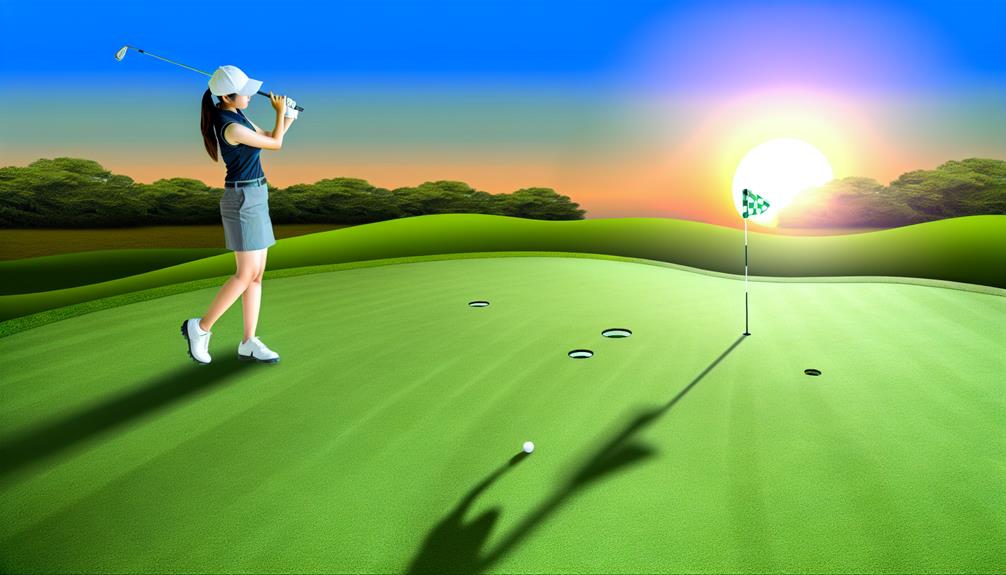Imagine you're an artist, about to create a masterpiece on a blank canvas. Your paintbrush is your putter, the canvas is the green, and each stroke you make is a putt.
Just as an artist needs to understand their tools, mediums, and techniques, so too must you understand the intricacies of putting to elevate your golfing game.
It's not just about sinking the ball into the hole – it's about precision, reading the green, selecting the right equipment, and consistent practice.
So what makes for effective putting green training? You might be surprised to find out it's not just about the hours you put in.
Understanding the Basics of Putting
To master the art of putting, you must first grasp the fundamental aspects such as proper stance, grip, alignment, and the art of reading greens. The grip, in particular, is crucial. It should be firm yet relaxed, like a handshake. Grip techniques vary, but the most common ones are the reverse overlap, the cross-handed, and the claw. Each has its merits and demerits, and it's important to experiment to find out which one suits your style.
Next, consider the stroke speed. It's not about how hard you hit the ball, but how smoothly you do it. A slow backswing followed by a faster follow through ensures a consistent stroke speed. Think of the stroke as a pendulum swing – smooth and controlled.
Alignment, too, is key. Your feet, hips, and shoulders should be parallel to the target line. It's also essential to read the greens correctly. Understanding the slope, grain, and speed of the green can help you judge the right line and speed for your putt.
Importance of Green Reading Skills
Mastering green reading skills can significantly improve your putting game, as it allows you to accurately predict the ball's path and speed. This requires a keen visual perception and the ability to analyze various cues on the green, such as slope, grain, and moisture levels. Understanding these elements is vital to determining the ball's trajectory and the force needed to reach the hole.
Expanding your perception strategies can be a game-changer. Start by taking a broad view of the green, then focus on the area around the hole. Look for any changes in color that might indicate changes in the grain or moisture. Walk around, feel the turf under your feet, and note any variations.
The next step is to visualize the ball's path. This is where your visual perception comes into play. Imagine the ball's trajectory, taking into account the greens' undulations and the force required to get the ball to the hole.
Green reading isn't just about seeing; it's about interpreting and predicting. It's a skill that, when mastered, can significantly enhance your performance on the green. So, invest time in honing these skills. Your game will thank you.
Training Techniques for Better Accuracy
While honing your green reading skills is crucial, equally important is adopting effective training techniques to improve your accuracy on the putting green. One such technique involves psychological preparation. You must train your mind to concentrate on each stroke, visualizing the path of the ball and the end goal. This mental focus can significantly enhance your accuracy.
In addition, body posture plays a pivotal role in your putting performance. Maintaining a balanced stance with your weight evenly distributed between both feet is essential. Your hands, arms, and shoulders should form a triangle, and your eyes should be over the ball. You're then in the perfect position to execute a smooth, pendulum-like stroke.
Practicing these techniques regularly will help you develop a consistent putting routine. Remember, repetition is key to ingraining these habits and boosting your accuracy on the green. Don't rush the process; be patient, and you'll gradually notice improvements.
The Role of Consistent Practice
As you delve into your putting practice, consistency is the key ingredient that can transform your performance on the greens. Consistent practice is like the heartbeat of your training regimen. It's not just about making the same movements; it's about fostering mental preparation and discipline. You have to train your mind to visualize the path of the ball, to manage stress, and to focus on the goal.
To achieve this, practice scheduling becomes vital. You can't expect to improve if your sessions are erratic or too infrequent. Set a schedule that's reasonably challenging yet achievable, and stick to it. This doesn't mean you have to practice for hours every day. Even a short, focused session can have a profound effect if done consistently.
Consistent practice also helps you develop a 'feel' for the greens. Every green is unique – they differ in speed, slope, and texture. By maintaining a regular practice routine, you become intimately familiar with these variations, improving your adaptability and overall performance.
In essence, the role of consistent practice in effective training on putting greens is paramount. It's the key to mastering mental preparation, staying disciplined, and enhancing your skill on the greens.
Enhancing Performance With Equipment Choices
Choosing the right equipment can significantly enhance your performance on the putting greens, making it an essential aspect of your training strategy. A key factor in this is grip selection. The grip you choose can affect your putting stroke, so it's crucial to select one that suits your particular style and comfort. Thicker grips can minimize wrist action, leading to a more stable stroke, whereas thinner grips can provide a greater feel.
Another vital component is putter design. The shape and balance of your putter can have a substantial impact on your putting success. Putter heads come in various designs, from blade to mallet and everything in between, each with their advantages. Blade putters, for example, offer a great feel and are typically preferred by more advanced players. Mallet putters, on the other hand, provide more stability and are often favored by beginners.

